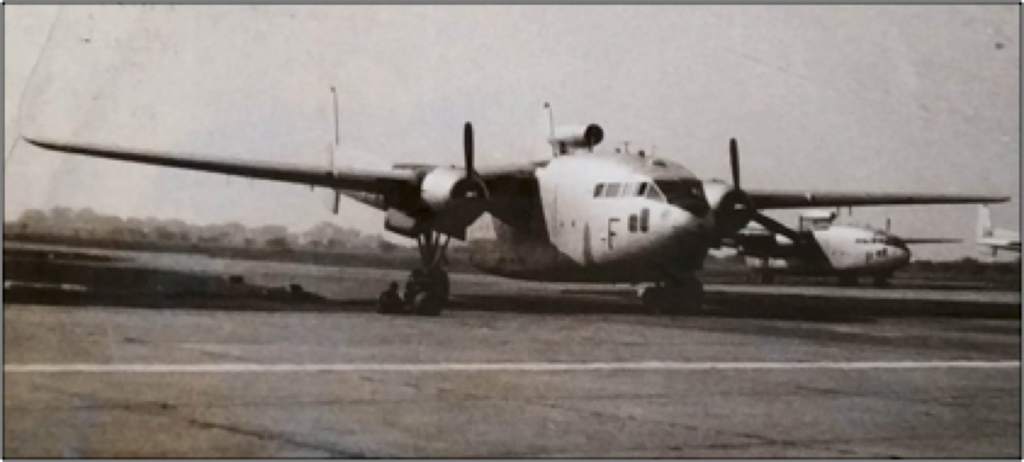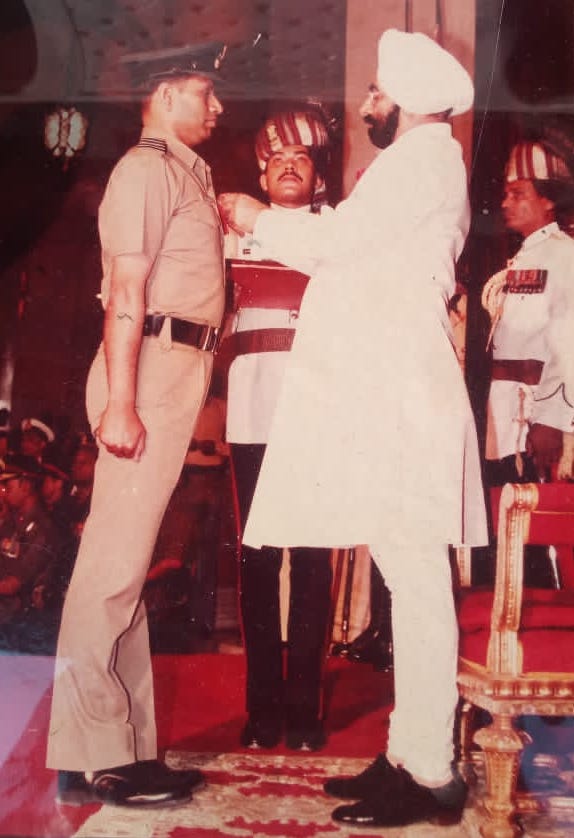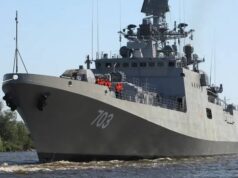Mid-Air Mission Impossible: The Legend of Gutsy Gaur

By
Group Captain Ashok K Chordia (Re-attired) Life, Military
Late that November evening in 1982, the Air Officer Commanding (AOC), Air Force Station Kheria (Agra) was the most concerned commander of the Indian Air Force. A ‘May Day‘ call from a C-119 Fairchild Packet aircraft of No 12 Squadron, Air Force, on a routine training flight had sent Air Commodore KK Badhwar rushing to the Air Traffic Control (ATC) tower. “There’s an emergency… Packet aircraft… problem with the nose landing gear… orbiting overhead… will approach for landing in about an hour,” he had been informed briefly by the air traffic controller on duty who was in a great hurry to drop the line––his attention, and all his energies were focussed elsewhere.
The ATC tower was abuzz; preparing to deal with the worst––the crash crew had been alerted; the crash tenders and the ambulances were ready, awaiting further orders. The routine take-off and landing of aircraft had been stopped altogether; all other aircraft had been advised to clear the airspace and the runway; everyone concerned, had been notified. Once in the control tower, the AOC conversed with Squadron Leader CK Jolly, the Captain of the aircraft, and gauged the gravity of the situation.
Minutes ago, when this Packet aircraft, call sign IK-461, was approaching Agra airfield for its sixth landing, the Captain had observed that on lowering the landing gear, the nose landing gear warning light had remained red. Steps to lower the nose wheel as per the Standard Operating Procedure (SOP) had been in vain––either the warning light indication in the cockpit was faulty, or the landing gear was actually malfunctioning. In the latter case, it was a serious emergency; the nosewheel landing gear could collapse on touchdown leading to a difficult-to-manage crisis situation. A few more checks confirmed the worst fears––it was a positive warning; the nose landing gear was actually dysfunctional.
C-119 Fairchild Packet was one-of-its-kind flying machine, if it could be called one. In appearance, it was quite un-aircraft-like; people marvelled at its ability to mock the laws of gravity and the Principles of Flight. Its designers called it a Flying Boxcar; others, less kind in their treatment of the aircraft, awarded it the epithet: ‘Flying Coffin’. It wouldn’t be much of an exaggeration if one were to declare that this aircraft of the Korean War vintage, of the early 1950s, used to get airborne and stay afloat more because of the willpower of the magnificent men who flew it––and those who enabled its flight; the technicians––than because of its powerful engines and large wingspan. Having served the USAF, and then the IAF, so very well for long years, the ageing machine demanded superior care and maintenance to remain airworthy. The memory of a crash on the take-off run, although not due to a technical snag, wherein a contingent of 42 paratroopers, five Parachute Jump Instructors and the aircrew had perished in a fireball, in the not-too-distant past, must have weighed heavily on the mind of the AOC as he listened to the conversation between the Controller and the Captain. Yet in that extremely charged atmosphere, he was quiet, composed and un-interfering. Air Commodore Badhwar, a decorated Canberra Bomber pilot and a hero of the 1971 Indo-Pak War (a Vir Chakra awardee), knew the air warriors under his command well. They were dutiful conscientious men who didn’t need hand-holding or nudging. Leadership!

Up there, in the aircraft…
There was practically no choice. The Captain had consulted the other crew members and the professionals who had gathered in the ATC tower, and had taken an informed decision to land. That decision would mean––a very high probability of the nose landing gear piercing through the aircraft structure on making contact with the runway surface; its propellers hitting the concrete; the engines and the airframe suffering damage and causing a major fire. The possibility of the aircraft cartwheeling due to one of the wings hitting the ground and ending up in a mangled mass of metal couldn’t be ruled out either. Threat to the lives of the seven air warriors onboard, was a given. The only thing they could do was to land with nearly empty fuel tanks to minimise the ferocity of the blaze. Decision to land anyway, had been taken. And, it was a unanimous decision… almost.
Mind it! A-L-M-O-S-T!
Among the crew was a young Flight Engineer whose mind was flying out of the Boxcar (pun intended). Flight Lieutenant Sumer Chand Gaur, “SC” to his friends, was an engineer instructor on type; knew the aircraft systems like the backside of his hand. He thought differently and was somehow unconvinced about the decision to land the aircraft in that condition. He didn’t accept what others saw as a fait accompli.
Flight Lieutenant Gaur reasoned with the Captain that the nose undercarriage was not lowering and locking due to an internal obstruction. He opined that it was possible, in-flight, to remove the jack from its attachments in the nose undercarriage bay and let the landing gear free to come down fully. A Qualified Flying Instructor himself, Squadron Leader Jolly understood the technicality very well, but wavered on the decision to attempt rectification. The solution was fraught with great risk and as a Captain, he was just not ready to expose his Flight Engineer to that danger.
A healthy debate ensued even as time, and fuel––the most precious commodities in that crisis––kept running out. Any one attempting to rectify the snag could accidentally fall off the aircraft to instant death. The Captain’s dilemma was: whether he should put Gaur’s life to risk in the hope that all seven lives might be saved or, not allow Gaur to attempt rectification and endanger all seven lives on touchdown.
The Captain remained caught up between the devil and the deep sea for a short while but then, gave in to the enthusiasm of his Flight Engineer. He allowed him to discuss the plan with the experts sitting in the ATC tower and to get another opinion. The AOC and the others listened attentively to Gaur on the radio set and grasped the technical viability of the solution suggested by him. But most of them thought he was volunteering for an extremely audacious action––almost impossible to execute––to solve the problem. It entailed hanging outside (below) the flying aircraft and working on the landing gear. Barnstorming!? A mistake while attempting it could send him hurtling 5,000 feet down, to mother earth.
All eyes were on the AOC.
Air Commodore Badhwar knew Flight Lieutenant Gaur as an energetic and enthusiastic young officer; a thoroughbred professional and a go-getter in that. He took little time to decide and was unflinching when he gave a nod to his gutsy plan of action. That indeed marked the beginning of a forty-seven-minute ordeal which, to those involved in it, would appear to be an eternity.
Moments into the exercise, the protagonists realised that the problem was far more complex than they had visualised. To begin with, the gap created by removing the panels from the floor of the aircraft was too small for a well-built Gaur to pass through. Also, the poorly lit space in the wheel bay was very crammed; there was hardly any elbow room. It was a struggle for him to squeeze into the rathole. Non-availability of proper tools on board made things more difficult––Jugaad turned out to be the watch word. Without wasting any time, Gaur got down to execute the Mission Impossible. One of his trainee Flight Engineers held his feet as he got himself lowered, head first, into the nosewheel bay.
November in Agra is rather cold. Incidentally, it was November the 25th––a day after SC’s 36th birthday. A ruthless December was less than a week away. At 7:45 pm, outside the aircraft it was dark and freezing.
In the wheel bay…
Cold air, at a hundred miles per hour, pierced SC’s face; and numbed his nose and cheeks. Within seconds, his eyes and nose started watering. Six to eight minutes was a very long time to work in that air blast. So, Gaur surveyed the landing gear and quickly withdrew into the cargo compartment for a breather. He had to thaw his frozen nose and clean his face which was, thanks to the wind chill, smeared with fresh saliva and mucous.
The very best in people comes to the fore when they are in life and death situations. It is as true about the grit and resilience of men in distress, as about their sense of humour. At a time when, they were unsure of seeing another sunrise, Squadron Leader Narwal, the Navigator did not miss any opportunity to crack jokes to lighten the mood even as Flight Lieutenant Gaur prepared to enter the nose wheel bay a second time. He stood precariously in the bay, clinging on to a strong point with one hand, and working on the landing gear with the other. The blast of cold air was relentless in its effort to dislodge the young engineer. His fingers frozen again, SC resurfaced into the cargo compartment––only to regain his breath, warm and revive his fingers and wipe his face. The process repeated––in about forty minutes, Gaur had been into the nosewheel bay five times. All this while the cockpit crew, and the AOC in the ATC tower listened, with bated breath, to the running commentary that was being broadcast by the Flight Signaller, Junior Warrant Officer Subbu who was keenly observing and relaying every piece of action.
With great effort, Gaur was able to unlock the nut holding the landing gear actuator––the bolt however, remained stuck. It was imperative to dislodge it to set the landing gear free. His attempts to remove it were fruitless. He needed a hammer to complete the task. Meanwhile, breathing was becoming a strain; he felt exhausted. One of the crew brought a cylinder of breathing oxygen with a mask to comfort him. Rejuvenated by a tonic of jokes and several lungfuls of oxygen, he got down to pushing the bolt out of its casing. For want of a hammer, he struggled with a large spanner.
Viva! At last, the adamant bolt slipped out. Then, without wasting another second, Gaur removed the actuator freeing the landing gear to move into fully down position. There was instant jubilation in the cockpit––the nosewheel undercarriage warning light had turned ‘Green.’ In the last action, SC inserted the Ground Lock Pin into the undercarriage to prevent its accidental retraction; he tied it with a lashing chain and jack to make it absolutely safe.
Although smiling, gutsy Gaur was numb and utterly sapped when he emerged from the nosewheel bay for the sixth, and the last, time. Down below, in the control tower, there was a feeble sense of celebration. Eeriness had pervaded the air. People had their fingers crossed as they waited for the aircraft to land. Cautiously, Squadron Leader Jolly made a perfect landing and switched off the engine power instantly. With minimum use of brakes, he carefully brought the aircraft to a halt at the end of the long runway.
The AOC arrived instantly at the head of a convoy of vehicles––crash tenders, fire tenders, ambulances and cranes. With arms wide open and a smile that conveyed everything, he welcomed the crew. After a warm hug, he offered his overcoat to SC who was still shivering. He learnt about the incident from Gaur and Jolly, as he drove them to the Flight Commander’s Office where cups of much sought hot coffee awaited them. After completing the documentation, the crew of IK-461, headed to the Squadron Commander’s residence to celebrate a happy end to their ordeal. The celebration continued into the wee hours of the morning.
For a display of professionalism of the highest order and selfless devotion to duty under extremely perilous circumstances, Flight Lieutenant Sumer Chand Gaur was awarded the coveted Shaurya Chakra (exceptional peacetime gallantry) by Giani Zail Singh, the then President of India. Still later, in recognition of his distinguished services, he was awarded the Vishishth Seva Medal.

Now a veteran, Group Captain SC Gaur SC, VSM, resides in Ghaziabad. When the ever-so youthful and daring officer is not playing golf, he spends time motivating youth. The legacy must live; the baton must be passed on.
Source : akchordia.com




